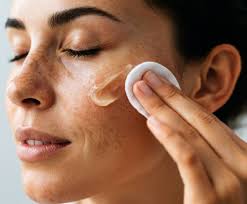
Vicks VapoRub for your Face
For years people have claimed that Vicks Vapor Rub improves wrinkles, sagging skin, stretch marks and mosquito bites. Is this true? Is Vapor Rub (or VapoRub) safe for use on the face? I am a dermatologist in Miami and one of my patients asked me this last week. Evidentially in the Latin community, Vicks VapoRub is often used for skin ailments. Let’s look at the ingredients in Vapor Rub first and then if it can treat any skin conditions. Under this video, I get into the scientific details of how this vapo rub works and doesn’t work in skin care.
As a thank you for reading our educational content, use the one-time code “STSBlog20” at checkout for 20% off anything in our store.
Is Vicks Vapo Rub Good for Skin?
Vicks Vapo rub is a cough suppressant in an occlusive ointment that is used on the chest when you have a cold. However, it has a cult following of people who use it on pimples to get rid of them fast. Vaporrub has camphor and menthol that give the skin a soothing sensation and numb the skin, but do not have any effects on inflammatory pathways in the skin and do not decrease skin inflammation, even though they give the sensation of healing. Below I discuss the ingredients in Vicks Vapor rub, what they do, and what conditions Vapor rub has been used to treat. Does Vicks Vapor Rub really tighten and firm skin and get rid of sagging? Stay tuned to find out.
Vapo Rub for Wrinkles
Vapor Rub does not get rid of fine lines and wrinkles permanently, but can irritate the skin and cause swelling which makes them look better temporarily. However, I advise not to use Vicks Vapor Rub on the face at night for antiaging reasons. The reason people us Vapor Rub as an Anti-wrinkle Treatment is because of the eucalyptus oil in the Vapor Rub, but the other ingredients in the product can irritate your skin.
Eucalyptus Oil for Wrinkles
Eucalyptus oil is one of the major components of Vicks VapoRub, and plays a huge role in how it works. Recent studies have explored the potential anti-aging effects of the essential oil from Eucalyptus globulus leaves (eucalyptus oil), a key ingredient in Vicks VapoRub. (3,4) Eucalyptus oil was shown to reduce the number of senescent cells, which accumulate with age and contribute to skin aging. Eucalyptus oil inhibits the activity of matrix metalloproteinases, enzymes that break down collagen, while increasing collagen production. By targeting senescent cells and preserving extracellular matrix proteins like collagen and hyaluronic acid that provide structural support in the skin, eucalyptus oil may be beneficial in treating age-related skin changes such as wrinkles. However, the other components in Vicks VapoRub may irritate skin, so you are better off using Eucalyptus oil on it’s own- assuming you are not allergic to it like I am.
Best Treatments for Wrinkles
If you are looking for a night cream that really works for wrinkles- don’t use Vapor Rub. Use one of these proven ingredients instead:
Exosomes
Growth Factors
Retinoids
Vitamin C
[[T46]]
VapoRub for Sagging Skin
Does Vapo rub work for sagging skin? Maybe… If so- it is due to the eucalyptus oil.
Eucalyptus oil may help firm and tighten sagging skin, but more studies need to be done on humans to prove this. One study (5) found that Eucalyptus globulus (EG) extract protects against UVB-induced skin aging. When applied to the skin of UVB-exposed hairless mice, EG extract increased expression of elastin, an important protein that keeps skin flexible and elastic with the ability to bounce back. Additionally, the extract decreased levels of MMP-1, an enzyme that breaks down elastin and other structural proteins in aged/damaged skin. MMP-1 is very similar to elastase, another enzyme that degrades elastin. By boosting elastin production and suppressing MMP-1/elastase, EG extract helped maintain healthy skin structure and reduced wrinkling in the hairless mice. In summary, topical application of Eucalyptus globulus extract combated skin aging in UVB-irradiated mice by increasing elastin levels and decreasing collagen-damaging MMP-1 enzymes that are functionally similar to elastases. Although this study did not measure skin elasticity, thickness or sagging, eucalyptus extract shows promise as an anti-aging skin treatment.
VapoRub for Acne and Pimples
The menthol and camphor in Vicks Vapo rub may cause acne breakouts, while th eucalyptus oil can help treat acne.
Although this has not been specifically studies are there are no evidence based studies, Vicks VapoRub could trigger an acne breakout due to its potential for increasing inflammation. This could occur for several reasons:
Allergy or Irritation: Ingredients in VapoRub, like menthol and camphor, could irritate the skin, especially if it’s sensitive or already prone to acne. Irritation can exacerbate acne symptoms.
Increased Blood Flow: These ingredients might increase blood flow to the skin, potentially intensifying inflammation and exacerbating acne.
TRPV Activation: Menthol and camphor interact with TRP channels, particularly TRPV1 and TRPA1, which are involved in the skin’s inflammatory response. The activation of these channels can contribute to neurogenic inflammation, a process relevant in various skin conditions. By potentially affecting these pathways, VapoRub’s ingredients might increase the likelihood of acne flare-ups.
Understanding the complex nature of acne and skin inflammation is crucial, and while Vicks VapoRub makes skin tingle which feels like it is healing the skin, it can actually make acne worse. It doe snot make pimples or pimple scabs heal faster.
Acne Spot Treatment
Eucalpytus oil may help the inflammation seen in acne and can be used as a natural acne spot treatment. Studies (15) have demonstrated that eucalyptus oil and eucalyptol have antimicrobial effects against a variety of microbes including viruses, drug-resistant bacteria, and fungi like Candida. Beyond antimicrobial properties, eucalyptus oil has also exhibited immunostimulatory, antioxidant, anti-inflammatory, analgesic (pain-relieving), and antispasmodic properties.
However, Vapor Rub has other components in it that are comedogenic. So if you are considering using Vicks VapoRub as an acne spot treatment, try eucalyptus oil instead (or tea tree oil).
VapoRub for Rosacea
Never use Vicks Vapor Rub to treat facial redness or rosacea. It can trigger a rosacea flare!
VapoRub for Sunburn
Vaporub may sooth the pain of a sunburn. However, there are better topical anti-inflammatory ingredients to use for sunburn like aloe.
VapoRub for Bug Bites
Living in Miami, I see patiernts all the time with mosquito bites. Vicks VapoRub is one way to decrease the itching. It is important not to scratch bug bites- so I do think vapor rub is a good option to treat bug bites.
VapoRub for Stretch Marks
While there have been anecdotal reports of individuals successfully using Vicks VapoRub to improve the appearance of stretch marks, there is no scientific evidence to support these claims. I do not see any scientific reason that Vicks VapoRub would prevent or treat stretch marks.
VapoRub in Pregnancy
Pregnant women should consult their healthcare provider before using Vicks on stretch marks or large areas of skin. There is turpentine oil and other ingredients that cause increase skin penetration of other ingredients. These can make into the blood stream and possible to the baby. So do not use VapoRub on large areas on the body in pregnancy.
If you are trying to prevent stretch marks or treat itching in pregnancy- use a soothing oil instead.
[[T10]]
Ingredients in Vicks VapoRub
Vicks Vapor Rub includes both active and inactive ingredients that contribute to its unique properties. Many of these can irritate the skin and lead to a contact dermatitis. Many are also comedogenic.
Active Ingredients in Vicks VapoRub
Camphor (Synthetic) 4.8%: Used as a cough suppressant and topical analgesic. Camphor contributes to the warming sensation and interacts with pain receptors.
Eucalyptus Oil 1.2%: Acts as a cough suppressant, providing a soothing sensation and known for its pleasant aroma.
Menthol 2.6%: Also a cough suppressant and topical analgesic, menthol is responsible for the cooling sensation and helps in relieving minor aches.
Inactive Ingredients:
Although these Vapor Rub ingredients are called “Inactive”, they still have skin effects:
Cedarleaf Oil: Known for its aromatic properties.
Nutmeg Oil: Often used in balms for its soothing fragrance and potential warming effect.
Petrolatum: Serves as a base for the ointment, helping in skin application.
Thymol: Known for its antiseptic properties.
Turpentine Oil: Traditionally used in topical remedies, adds to the ointment’s characteristic smell.
TRPV Receptors
The interaction of Vicks VapoRub’s active ingredients, particularly camphor and menthol, with TRPV receptors explains much of its effects on the skin. These receptors, sensitive to various stimuli, respond to the cooling and warming sensations induced by menthol and camphor, respectively.
Research shows that menthol and camphor, due to their interaction with TRPV receptors, have potential analgesic and anti-inflammatory effects, beneficial in certain conditions like migraine or joint pain. But they have not been shown to help treat skin inflammation, skin sensitivity, or acne. And these ingredients can make the skin sting.
While Vicks VapoRub’s unique blend of ingredients offers certain benefits, its application on the face, especially for conditions like acne or sunburn, is not advisable due to the potential for irritation. For mosquito bites, it can be an effective remedy. Always consider individual skin types and consult a dermatologist for personalized advice.
VapoRub Skin Routine
VapoRub is an occlusive ointment so it “slugs” other ingredients into the skin. When Vicks Vaporub is used in a face routine- it is usually used at night because it is so greasy du to all the oils in it.
It will irritate most skin types and I do not advise using it. If you are looking for a good skin care routine- first you need to know which Baumann Skin Type you are. Once you take the quiz, I will give you lists of products from over 60 brands that are right for your skin type.
Vicks is not a strong anti-aging product
Vapo rub does not moisturize the skin
Inflammation caused by overusing vapo rub can trigger acne and other concerns


